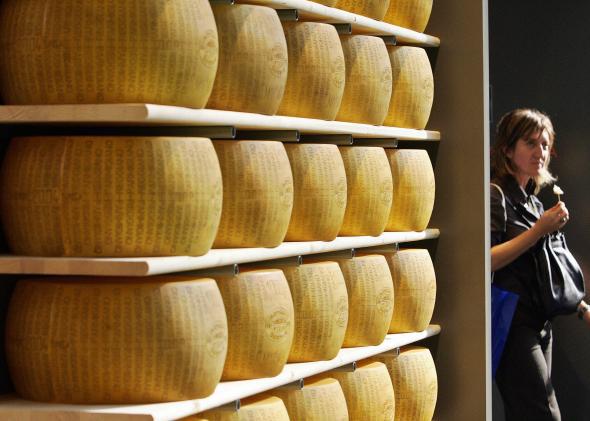The Food and Drug Administration has long had an adversarial relationship with traditional cheesemakers. First, it cracked down on raw milk cheese aged less than 60 days, even though such cheeses—like Brie de Meaux and Reblochon—have been safely devoured in Europe for centuries. Then it restricted imports of Mimolette, a hard orange French cheese, because of its high concentration of microscopic bugs called cheese mites—never mind that cheese mites are what give Mimolette its characteristic flavor and texture. Now, under the authority of the Food Safety Modernization Act of 2011, an FDA representative has announced that it will not allow cheesemakers to ripen or age cheese on wooden boards, because “Wooden shelves or boards cannot be adequately cleaned and sanitized.”
Jeanne Carpenter at the blog Cheese Underground has an excellent summary of the rule explaining its potential implications for producers and consumers:
Many of the most awarded and well-respected American artisan cheeses are currently aged on wooden boards. … Wisconsin cheesemaker Chris Roelli says the FDA’s “clarified” stance on using wooden boards is a “potentially devastating development” for American cheesemakers. … Roelli, like hundreds of American artisanal cheesemaekrs, has developed his cheese recipes specifically to be aged on wooden boards.
“The very pillar that we built our niche business on is the ability to age our cheese on wood planks, an art that has been practiced in Europe for thousands of years,” Roelli says. Not allowing American cheesemakers to use this practice puts them “at a global disadvantage because the flavor produced by aging on wood can not be duplicated.”
In addition to the wood-aged American cheeses mentioned by Carpenter—including Pleasant Ridge Reserve (a gruyere-like raw-milk cheese), Cabot Clothbound cheddar, and Marieke Feonegreek (a gouda from Wisconsin)—imported cheese will also be affected by the newly articulated rule. I spoke to Rob Kaufelt, the owner of Murray’s Cheese in New York, and he provided the following list of European cheeses that are commonly ripened or aged on wood:
In case you missed that: Parmigiano Reggiano. In short, this rule, if consistently enforced, will both throw an enormous wrench into many American cheesemakers’ operations and drastically shake up the availability of many beloved European cheeses.
So why has the FDA decided to crack down on wooden boards? According to a letter sent to the New York State Department of Agriculture and Markets by FDA representative Monica Metz, “The porous structure of wood enables it to absorb and retain bacteria, therefore bacteria generally colonize not only the surface but also the inside layers of wood. The shelves or boards used for aging make direct contact with finished products; hence they could be a potential source of pathogenic microorganisms in the finished products.”*
Federal food safety agents are particularly worried about listeria, which can indeed grow on poorly maintained wooden boards. But well maintained boards are home to a rich ecosystem of bacteria and fungi that are harmless to human health yet crucial to cheese texture and flavor. A 2007 study of eight different Reblochon producers’ wooden boards found that all of them had virtually the same mix of yeasts and molds (or, in scientist-speak, “the total counts and the predominant microflora showed a surprising homogeneity between origins of cheeses”). The wood’s microflora is part of what makes Reblochon Reblochon, Comté Comté, and Beaufort Beaufort. If ever there’s been a case of throwing out the baby with the bathwater, it’s the FDA’s position on wooden boards.* And if the FDA hasn’t yet figured out that not all bacteria are bad bacteria, well, I don’t think I want them looking out for my health.
So far, this story has gotten a lot of traction in the right-wing media as a prime example of the oppression of Obama’s America. (The first line of Rightwing News’ post about the cheese rule: “Tyranny has existed throughout human history, but modern liberalism is unique in that its proponents grind under their heels even the most innocuous and irrelevant aspects of society.”) But libertarians aren’t the only ones with a vested interest in this story. Everyone who loves cheese should start stocking up on Comté now. And maybe write the FDA’s dairy branch an email while you’re at it.
Update, June 10, 2014: The FDA has released a statement that kind of contradicts Metz’s assertion that wooden boards don’t conform to FDA standards and kind of reiterates it. Metz’s letter read, “The use of wooden shelves, rough or otherwise, for cheese ripening does not conform to cGMP [Current Good Manufacturing Practice] requirements, which require that ‘all plant equipment and utensils shall be so designed and of such material and workmanship as to be adequately cleanable, and shall be properly maintained.’”
The FDA’s new statement reads,
Historically, the FDA has expressed concern about whether wood meets this requirement and has noted these concerns in inspectional findings. FDA is always open to evidence that shows that wood can be safely used for specific purposes, such as aging cheese.
The FDA will engage with the artisanal cheese-making community to determine whether certain types of cheeses can safely be made by aging them on wooden shelving.
In other words, it looks like the burden of proof is on cheesemakers to show that wooden boards are safe, rather than on the FDA to show that wooden boards are dangerous.
Correction, June 10, 2014: This post originally misidentified the source of Metz’s quotations about wood’s bacteria-retaining properties. The quotes in this article are from a letter Metz wrote to the New York State Department of Agriculture and Markets, not from a public statement. The original version of this post also misidentified the FDA’s current position on wooden boards as a “ban”; the FDA claims that it is “open to evidence that shows that wood can be safely used for specfiic purposes.”
